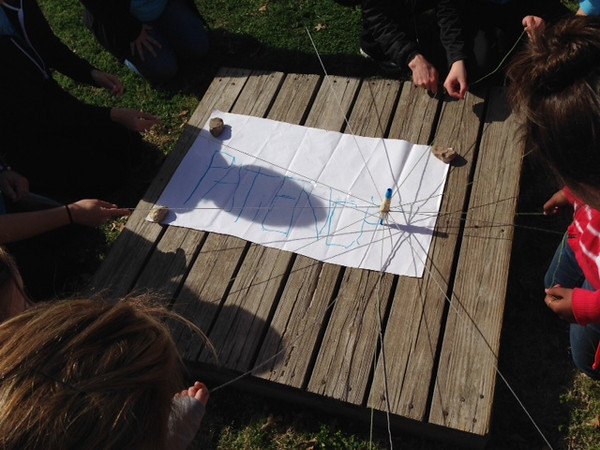Encourage your students to think about how they can be advocate for effective habitat in our National Parks
PURPOSE
When is habitat not effective habitat? When it can’t be used by grizzly bears and other wildlife. Discover the problems that can arise when we fill up protected areas with ‘human stuff.’ This activity uses data and techniques used by researchers in Banff National Park. Habitat Effectiveness uses a mathematical approach to assess how human use in grizzly country impacts potential bear habitat.
GRADE LEVELS
7-9
TIME NEEDED
90 minutes

Curriculum LINKS
Science 7A: Interactions and Ecosystems Outcomes 1,3,4
Science 9A: Biological Diversity Outcomes 1,4
MATERIALS NEEDED
Pencil, eraser, pencil crayons, calculator
Download: Student worksheet (pdf)
Download: Teacher solution sheet (pdf)
Instructions
- Have students brainstorm and write down on a separate sheet of paper what desirable grizzly bear habitat would look like and explain why. Have them also consider what would constitute an undesirable area. Grizzly bears choose habitat that has the following attributes:
-
- Food! A large, mainly herbivorous animal such as a grizzly is always hungry and chooses habitat with lots of foodstuffs
- Low-elevation, open valley bottoms. This is where food is more abundant. Higher elevation areas, such as the alpine ecoregion above the treeline, offer only a short growing season and are commonly cold, rocky, snowy or icy – not the place to find a lot of food (except for a short period in midsummer).
- Show students the cartoon that illustrates the relationship between potential habitat, habitat effectiveness and realized habitat. Human use can affect habitat, and reduce its ‘potential value’ to ‘realized value.’ Ensure that students understand that great bear habitat may become unusable for bears if human activities are intense enough in the area.
- Refer students to the table entitled Grizzly Bear Habitat in Banff National Park. The column labeled ‘Potential Habitat’ gives a value for a particular BMU (Bear Management Unit) that was calculated by researchers based on the quality of that habitat for bears – NOT CONSIDERING the effects of humans (e.g. people, roads, etc) in that area.
- On the map labeled Grizzly bear habitats for BMU’s students will use pencil crayons to shade in the regions according to the values on the supplied chart. For example, if the potential habitat value on the chart is 1.5, it is considered low potential. All regions that are less than 2.9 on the chart should be filled in with the same pattern. It is important to use pencil crayons, not markers.
-
- Ask the students:
- Why are there different values for potential habitat in the three mountain parks?
- Grizzly bears prefer to live at elevations under 8000 feet (valley bottoms) where there is a large amount of high quality berries. These regions have a high potential habitat value. Regions above 8000 feet, or that have poor quality vegetation (lakes, dense forest) have a low potential habitat value.
- Grizzly bears prefer to live at elevations under 8000 feet (valley bottoms) where there is a large amount of high quality berries. These regions have a high potential habitat value. Regions above 8000 feet, or that have poor quality vegetation (lakes, dense forest) have a low potential habitat value.
- Why are there different values for potential habitat in the three mountain parks?
- Direct students to examine the values in the next column: ‘Realized Habitat.’ Ask students if these numbers are higher or lower than the potential habitat column. Ask them what they think ‘Realized Habitat’ refers to. Realized habitat is simply a percentage of the potential habitat after taking into account disturbance factors from human use: people, buildings, roads, traffic, etc. It is a measure of the amount of the potential habitat that the bear is actually using.
- Students scrutinize the maps they just made, and if necessary use eraser to ‘downgrade’ the habitat from potential to realized habitat – reflecting the fact that there are many human disturbances to this natural ecosystem. Have students cross out “Potential” and replace with “Realized” in the title of the map. Discuss possible factors influencing the realized habitat values. These would include the Trans-Canada Highway and human settlements like the town of Banff and Lake Louise Village.
- Ask students to study the chart once more, and have them calculate and fill in the ‘Habitat Effectiveness’ in the blank column on the chart.
- Habitat Effectiveness = Realized habitat / Potential habitat
- (e.g. – BMU #1 has a potential value of 1.5 and a realized value of 1.0. so 1.0/1.5= .67 or 67%)
- On the map labeled Habitat effectiveness for Bear Management Units… students colour in the areas of different habitat effectiveness values using the values from the table, following the legend provided on the map. This final map reveals effective habitat for grizzly bears in Banff National Park.
- Ask students: Why does habitat effectiveness vary in the 40 Bear Management Units? What human features would you expect to find in those BMUs with values less than, say, 70%?
- Human features like towns, buildings, roads, railways and ski hills are often found in Bear Management Units that are less than 70%.
- Human features like towns, buildings, roads, railways and ski hills are often found in Bear Management Units that are less than 70%.
- Ask students: BMU 22 has a higher potential habitat value but a lower realized habitat value than BMU 21. Why is there such a difference between the two neighboring BMUs?
- Show students the map labeled, Significant human features in Banff, Yoho and Kootenay National Parks to help answer this question.
- BMU 22 has a higher potential habitat value than BMU 21 because it is a flat, valley bottom that is unimpeded by large lakes. Almost all of BMU 22 could potentially be used by grizzly bears.
- BMU 21 has a lower potential habitat value because of a large lake called Lake Minnewanka. This lake is of little use to a grizzly bear.
- BMU 22 has a lower realized habitat value than BMU 21 because of the presence of the town of Banff. The town of Banff, located in BMU 22 is densely populated by humans and is situated very close to the Trans-Canada highway.
- Similarly, Lake Louise village is located at the junction of BMUs 8, 10, 11, 9, 17. Grizzlies are very sensitive to human disturbance, and can’t successfully forage/live near human activities.
- Ask students: What if anything should Parks Canada do to increase habitat effectiveness values in these three national parks?
- Researchers’ recommendations to increase habitat effectiveness values in our National Parks include the following:
- Particular attention should be given to preventing further loss of habitat effectiveness especially in high quality habitats (valley bottoms) where highly suitable seasonal grizzly bear habitat exists. This may mean limiting human developments.
- Steps should be considered to increase habitat quality for grizzlies. Limiting human access in grizzly habitat, the use of fire, and the creation of selective clearings can potentially enhance grizzly bear habitat.
- Human impacts on movement areas that grizzly bears use should be managed at levels that will encourage movement by grizzly bears.
- To see up-to-date news about what Parks Canada is doing to protect grizzlies in Banff National Park, visit: https://www.pc.gc.ca/en/pn-np/mtn/ours-bears/gestion-management
- Ask students: What can we/visitors to BNP do to influence habitat effectiveness?
- Drive less through BNP
- Drive the speed limit
- Avoid causing “Bear Jams” – do not stop to take pictures of bears near roads
- Avoid trails/campgrounds with “Bear in Area” signs
More Bring Nature Home for Teachers
Bring Nature Home is our online database of tried-and-tested CPAWS Southern Alberta activities! Here are some ways that you can bring nature home (or to the classroom) today!

Words With Strings

Sound Stalk Game

